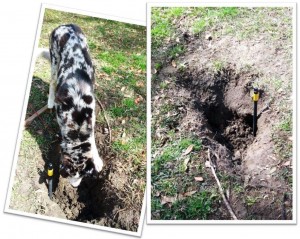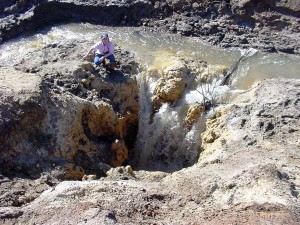
This tiny sinkhole appeared in my yard during the heavy March rains. Although only 3 feet wide, it was 5 feet deep. My dog looks both curious and jealous that it wasn’t one of the holes he’s dug!
During our heavy March rainfall events a tiny sinkhole appeared in my yard. While it was only 3 feet across, it was over 5 feet deep! After reading about the various types and causes of sinkholes, I decided it was most likely a “subsidence incident” sinkhole caused from collapsed underlying organic material (perhaps an old tree root?). Read on to learn more about sinkholes, their causes, and their prevalence in Florida.
Sinkholes are a fascinating, common, and sometimes tragic characteristic of Florida’s landscape. They are one feature of “karst” terrain which is quite prevalent in Florida. Other features of karst terrain include caves, springs, disappearing streams, and underground drainage systems. Karst terrain “is a type of topography that is formed by dissolution of bedrock in areas underlain by limestone, dolostone or, as in some western states, gypsum….The term karst, therefore, refers to the terrain and the term sinkhole is one of the types of drainage features reflected by that type of terrain. Other subterranean events can cause holes, depressions or subsidence of the land surface that may mimic sinkhole activity. These include subsurface expansive clay or organic layers which compress as water is removed, collapsed or broken sewer and drain pipes or broken septic tanks, improperly compacted soil after excavation work, and even buried trash, logs and other debris… Such an event is called a “subsidence incident.” (Source: Florida Dept of Environmental Protection http://dep.state.fl.us/geology/geologictopics/sinkhole.htm)
According to the United States Geological Survey and the Florida DEP Bureau of Geology, panhandle Florida’s limestone bedrock is overlain with from zero to over 200 feet of sediments. The depths and types of these overlying sediments are major factors in the prevalence and characteristics of sinkholes and other karst features. View this map to see an overview of sediment depth and sinkhole activity in your county. Leon County, in eastern panhandle Florida, boasts its geologically active Lake Jackson, not only for its famous largemouth bass fishery, but also for its periodic disappearances through underlying sinkholes! This 4,000 acre lake has a history of virtually draining through underlying sinkholes about every 25 years. Its most recent draining event was in 2006.

This is the sinkhole that drained Leon County’s Lake Jackson in 2006. The author is kneeling at its edge.
Please visit the following links for more information, including answers to questions such as:
- I think I have a sinkhole in my yard. What should I do?
- How do I fill in a sinkhole?
- Will watering our lawn lower the water table level and thus, cause sinkholes to develop in our neighborhood?
- Is there a government agency that will come and inspect my sinkhole?
- What is the sinkhole risk factor associated with my area?
- Is there a database showing all sinkholes in Florida?
- Our insurance company has informed us that the area where we are going to purchase property is listed as a sinkhole area. What does this mean? What can we do about it? Should we buy in that area?
Florida DEP, Bureau of Geology, All about Sinkholes, Questions and Answers.
Sinkhole Type, Development, and Distribution in Florida – A Map
UF/IFAS Disaster Handbook – Sinkholes
Sinkholes and Catastrophic Ground Collapse: What Every Floridian Should Know
- Maintaining Dissolved Oxygen Levels in Your Pond to Reduce Fish Kills - November 9, 2018
- A Look at Some of Our Colorful and Intriguing Native Bees - September 14, 2018
- Grass Carp – A Biological Control “Tool” to Manage Invasive Aquatic Plants - March 18, 2018
